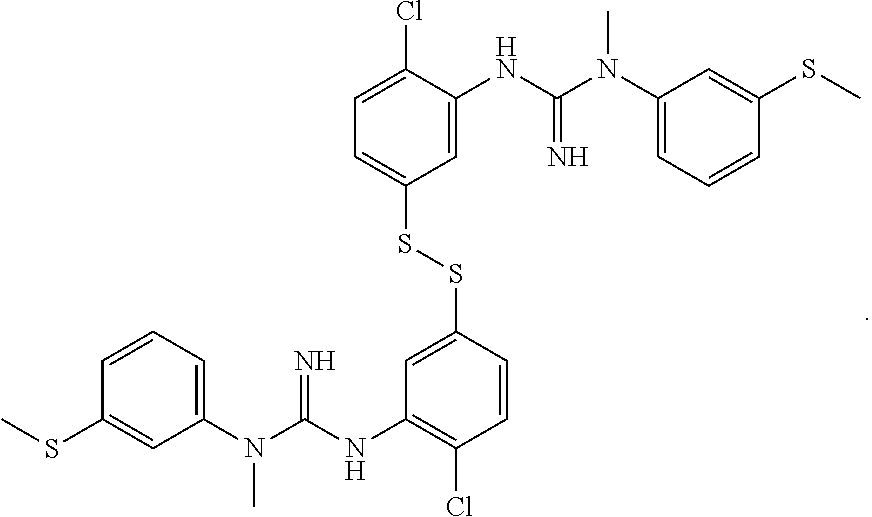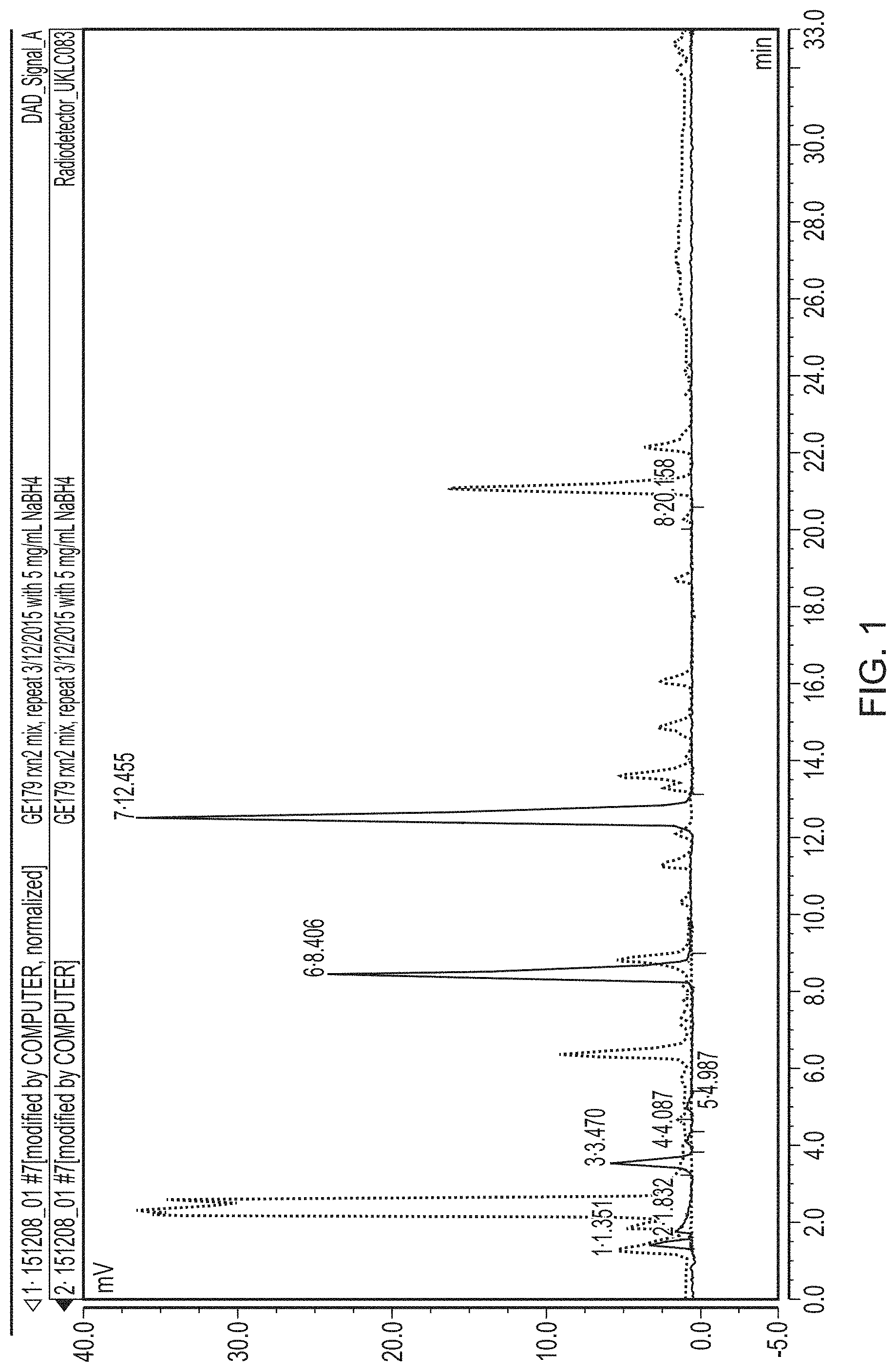Alkylation method
Khan , et al. Sep
U.S. patent number 10,759,747 [Application Number 16/097,571] was granted by the patent office on 2020-09-01 for alkylation method. This patent grant is currently assigned to GE HEALTHCARE LIMITED, KINGS COLLEGE LONDON. The grantee listed for this patent is GE HEALTHCARE LIMITED, KING'S COLLEGE LONDON. Invention is credited to Imtiaz Khan, Anna Kirjavainen, Graeme McRobbie.





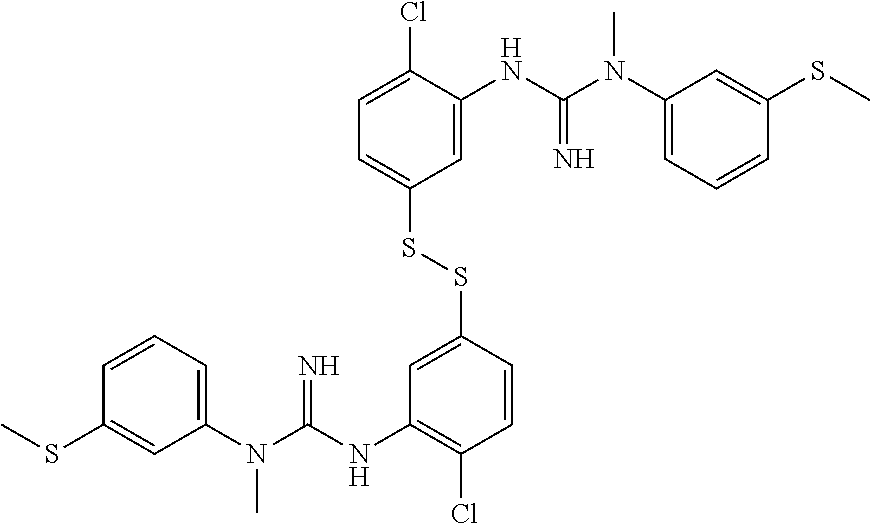

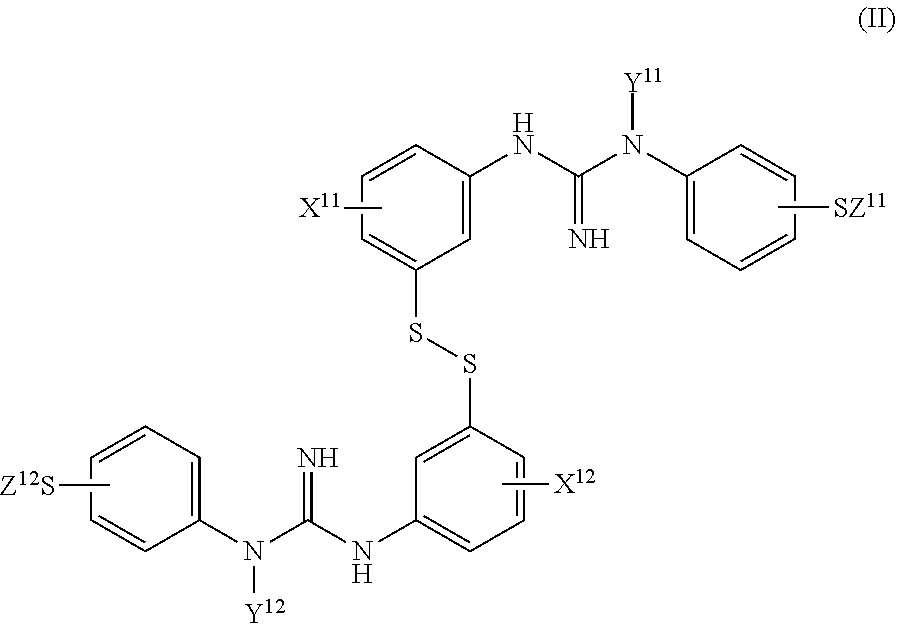


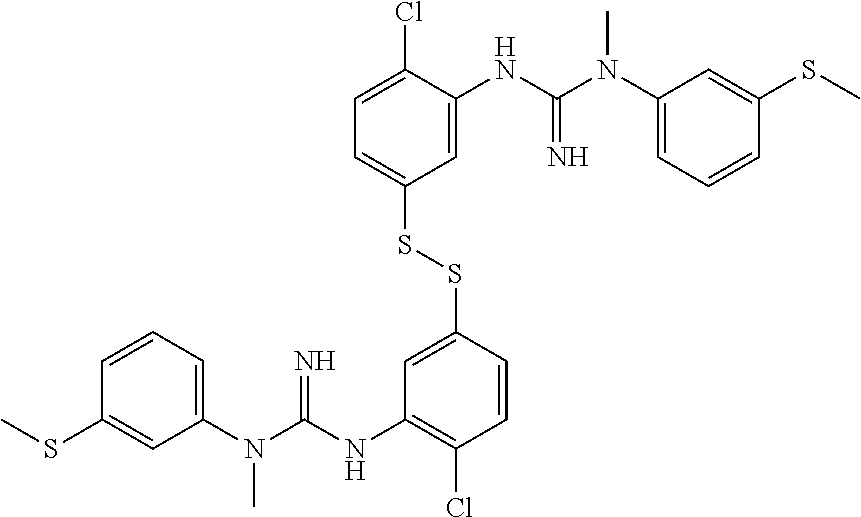
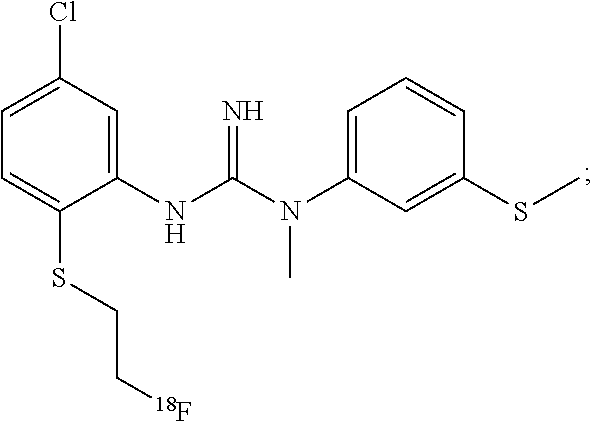
View All Diagrams
| United States Patent | 10,759,747 |
| Khan , et al. | September 1, 2020 |
Alkylation method
Abstract
The present invention relates to a method of radiochemical synthesis. Novel methods useful in the synthesis of a positron emission tomography (PET) tracer, and novel intermediates useful in said method are provided that have advantages over known methods.
| Inventors: | Khan; Imtiaz (Buckinghamshire, GB), McRobbie; Graeme (Buckinghamshire, GB), Kirjavainen; Anna (London, GB) | ||||||||||
|---|---|---|---|---|---|---|---|---|---|---|---|
| Applicant: |
|
||||||||||
| Assignee: | GE HEALTHCARE LIMITED
(Birmingham, GB) KINGS COLLEGE LONDON (Greater London, GB) |
||||||||||
| Family ID: | 56234186 | ||||||||||
| Appl. No.: | 16/097,571 | ||||||||||
| Filed: | May 2, 2017 | ||||||||||
| PCT Filed: | May 02, 2017 | ||||||||||
| PCT No.: | PCT/EP2017/060401 | ||||||||||
| 371(c)(1),(2),(4) Date: | October 29, 2018 | ||||||||||
| PCT Pub. No.: | WO2017/186969 | ||||||||||
| PCT Pub. Date: | November 02, 2017 |
Prior Publication Data
| Document Identifier | Publication Date | |
|---|---|---|
| US 20190161440 A1 | May 30, 2019 | |
Foreign Application Priority Data
| Apr 29, 2016 [GB] | 1607572.3 | |||
| Current U.S. Class: | 1/1 |
| Current CPC Class: | C07C 319/14 (20130101); C07C 319/14 (20130101); C07C 323/44 (20130101); C07B 2200/05 (20130101) |
| Current International Class: | C07C 319/14 (20060101) |
References Cited [Referenced By]
U.S. Patent Documents
| 2013/0060064 | March 2013 | Brathe |
| 2014/0243555 | August 2014 | Nairne |
| 103351317 | Jun 2005 | CN | |||
| 101253149 | Aug 2008 | CN | |||
| 102884043 | Jan 2013 | CN | |||
| 103857644 | Jun 2014 | CN | |||
| 103874672 | Jun 2014 | CN | |||
| WO 2004/007440 | Jan 2004 | WO | |||
| WO 2006/136846 | Dec 2006 | WO | |||
| WO 2011/141568 | Nov 2011 | WO | |||
| WO 2013/053940 | Apr 2013 | WO | |||
| WO 2013/053941 | Apr 2013 | WO | |||
Other References
|
Robins, Edward G., et al., "Synthesis and in vitro evaluation of 18F-labelled S-fluroalkyl diarylguanidines: Novel high-affinity NMDA receptor antagonists for imaging with PET", Elsevier Ltd., Bioogranic & Medicinal Chemistry Letters, 20, (2010), pp. 1749-1751. cited by applicant. |
Primary Examiner: Katakam; Sudhakar
Assistant Examiner: Sawyer; Jennifer C
Attorney, Agent or Firm: Culhane Meadows, PLLC Vockrodt; Jeff B.
Claims
The invention claimed is:
1. A method to obtain a compound of Formula I: ##STR00018## wherein: X.sup.1 is an X group selected from C.sub.1-4 alkyl or halo; Y.sup.1 is a Y group selected from hydrogen or C.sub.1-4 alkyl; Z.sup.1 is a Z group which is C.sub.1-4 alkyl; and, Q is [.sup.11C]C.sub.1-4 alkyl- or [.sup.18F]--C.sub.1-4fluoroalkyl-; wherein said method comprises: (i) reducing a compound of Formula II: ##STR00019## wherein: (ii) X.sup.11 and X.sup.12 are the same and are both an X group as defined for X.sup.1; Y.sup.11 and Y.sup.12 are the same and are both a Y group as defined for Y.sub.1; and, Z.sup.11 and Z.sup.12 are the same and are both a Z group as defined for Z.sup.1; and, (ii) adding a base to the product of step (i) and reacting with either [.sup.11C]C.sub.1-4 alkyl-LG.sup.1 or [.sup.18F]--C.sub.1-4 fluoroalkyl-LG.sup.2, wherein LG.sup.1 and LG.sup.2 are independently halo, or the group --O--SO.sub.2--R.sup.1 wherein R.sup.1 represents an optionally-substituted C.sub.6-10 aryl, an optionally-substituted C.sub.1-4 alkyl, or C.sub.1-4 fluoroalkyl; wherein the molar ratio of added base:thiol in step (ii) is in the range of about 0.2-0.75.
2. The method as defined in claim 1 wherein said compound of Formula II is a compound of Formula IIa: ##STR00020## wherein: X.sub.11 and X.sup.12 are the same and are both an X group as defined in claim 1; Y.sup.11 and Y.sup.12 are the same and are both a Y group as defined in claim 1; and, Z.sup.11 and Z.sup.12 are the same and are both a Z group as defined in claim 1.
3. The method as defined in claim 1 wherein said X group is halo.
4. The method as defined in claim 1 wherein said Y group is C.sub.1-4 alkyl.
5. The method as defined in claim 1 wherein said Z group is methyl.
6. The method as defined in claim 1 wherein said X group is chloro, said Y group is methyl and said Z group is methyl.
7. The method as defined in claim 1 wherein reducing step (i) is effected using a reducing agent selected from sodium borohydride (NaBH.sub.4), free phosphines, 1,8-Diazabicyclo[5.4.0]undec-7-ene (DBU), zinc in hydrochloric acid, zinc in acetic acid, magnesium in hydrochloric acid, sodium hydrogentelluride (NaTeH) in ethanol, lithium aluminium hydride (LiAlH.sub.4) in tetrahydrofuran, indium in ammonium chloride, and sodium hydride (NaH), or a solid bound reducing agent such as triphenyl phosphone or phosphine.
8. The method as defined in claim 1 wherein reducing step (i) is effected using NaBH.sub.4.
9. The method as defined in claim 1 wherein in said reacting step (ii) the thiol product is reacted with [.sup.18F]--C.sub.1-4 fluoroalkyl-LG.sup.2.
10. The method as defined in claim 1 wherein said compound of Formula I is: ##STR00021##
11. The method as defined in claim 1 wherein said compound of Formula II is: ##STR00022##
12. The method as defined in claim 1 wherein said reducing step (i) and said reacting step (ii) are carried out in the same vessel.
13. The method as defined in claim 1 wherein said reacting step is carried out in an ethanolic solution.
14. The method as defined in claim 1 wherein said reaction step (ii) is carried out for about 5-15 minutes.
15. The method as defined in claim 1 wherein said reaction step (ii) is carried out for about 5-10 minutes.
16. The method as defined in claim 1 wherein said reaction step (ii) is carried out for about 5 minutes.
17. The method as defined in claim 1 wherein said reacting step (ii) comprises about 0.02-0.04 mmol thiol.
18. The method as defined in claim 1 wherein said reacting step (ii) comprises about 0.02-0.035 mmol thiol.
19. The method as defined in claim 1 wherein said reacting step (ii) comprises about 0.03-0.035 mmol thiol.
20. The method as defined in claim 1 wherein said reacting step (ii) comprises about 0.005-0.025 mmol base.
21. The method as defined in claim 1 wherein said reacting step (ii) comprises about 0.01-0.025 mmol base.
22. The method as defined in claim 1 wherein said reacting step (ii) comprises about 0.02-0.025 mmol base.
23. The method as defined in claim 1 wherein said reacting step (ii) is carried out at a temperature between about 80-120.degree. C.
24. The method as defined in claim 1 wherein said reacting step (ii) is carried out at a temperature between about 100-120.degree. C.
25. The method as defined in claim 1 wherein said reacting step (ii) is carried out at a temperature between about 105-110.degree. C.
26. The method as defined in claim 1 wherein said reacting step (ii) is carried out at a temperature of about 110.degree. C.
27. The method as defined in claim 1 wherein said compound of Formula I is: ##STR00023## said compound of Formula II is: ##STR00024## said ratio of base:thiol is about 0.2-0.75; and, said reacting step (ii) is carried out for about 5 minutes at about 110.degree. C.
28. The method as defined in claim 1 which further comprises step (iii) purifying the reaction mixture obtained in step (ii) using solid phase extraction (SPE).
29. The method as defined in claim 28 wherein said SPE is carried out using one or more reverse phase SPE cartridges.
30. The method as defined in claim 29 wherein said SPE is carried out using one or more environmental tC18 SPE cartridges.
31. The method as defined in claim 30 wherein said SPE is carried out using two tC18 SPE cartridges.
32. The method as defined in claim 31 wherein chemical impurities are removed from said tC18 SPE cartridges using a basic aqueous acetonitrile solution and said purified compound of Formula I is eluted from said tC18 SPE cartridges with an ethanol solution.
33. The method as defined in claim 32 wherein said ethanol solution is an acidified ethanol solution.
34. The method as defined in claim 1 wherein said method is automated.
Description
CROSS-REFERENCE TO RELATED APPLICATIONS
This application is a 35 U.S.C. 371 National Phase of PCT Application No. PCT/EP2017/060401, filed on May 2, 2017, which claims priority to GB Application No. 1607572.3 filed Apr. 29, 2016, the disclosures of each of which are hereby incorporated by reference in their entirety.
The work leading to this invention has received funding from the People Programme (Marie Curie Actions) of the European Union's Seventh Framework Programme (FP7/2007-2013) under REA grant agreement Number 316882.
TECHNICAL FIELD OF THE INVENTION
The present invention resides in the field of chemical synthesis. More specifically, the present invention relates to novel methods useful in the synthesis of a positron emission tomography (PET) tracer, and novel intermediates useful in said method.
DESCRIPTION OF RELATED ART
WO 2004/007440 and WO 2006/136846 describe radiolabelled guanidine derivatives and their use for imaging central nervous system (CNS) receptors and teach synthesis of these radiolabelled derivatives from precursor compounds. For example, WO 2006/136846 teaches a compound of Formula (A):
##STR00001##
or a salt or solvate thereof, wherein:
R.sup.1 is hydrogen or C.sub.1-4 alkyl,
R.sup.2 and R.sup.4 are each independently selected from C.sub.1-4 alkyl, [.sup.11C]--C.sub.1-4alkyl, and [.sup.18F]--C.sub.1-4 fluoroalkyl provided that at least one of R.sup.2 and R.sup.4 is [.sup.11C]--C.sub.1-4alkyl or [.sup.18F]--C.sub.1-4 fluoroalkyl, and,
R.sup.3 is halo.
WO 2006/136846 teaches that the above compound of Formula (A) is synthesised by reaction of a suitable source of .sup.11C or .sup.18F with a precursor compound of Formula (B):
##STR00002##
wherein one of R.sup.2 or R.sup.4 is hydrogen, and the other is hydrogen, C.sub.1-4 alkyl, or a thiol protecting group such as benzyl; R.sup.1 is hydrogen or C.sub.1-4 alkyl, and R.sup.3 is halo.
WO 2006/136846 also teaches that the method to obtain the precursor compound of Formula (B) above wherein R.sup.2 is hydrogen is based on that disclosed by Hu et al (J. Med. Chem. 1997; 40(26): 4281-9), wherein a compound of Formula (C):
##STR00003##
or a salt or solvate thereof, wherein R.sup.3 is halo and P.sup.1 is a thiol protecting group; is reacted with a compound of Formula (D):
##STR00004##
wherein R.sup.1 is hydrogen or C.sub.1-4 alkyl and R.sup.4 is as defined for the desired compound of Formula (B).
This method has also been recently reported by Robins et al (2010 Bioorg Med Chem Lett; 20: 1749-51) as a successful way to obtain the following .sup.18F-labelled S-fluoroalkyl diarylguanidines:
##STR00005##
WO 2011/141568 developed the above-described methods further by using a dimeric precursor compound of the following structure:
##STR00006##
The above disulfide precursor is reduced to the thiol prior to reaction with a radiolabelled alkylating agent in order to obtain the above-described radiolabelled guanidine derivatives.
There is scope to improve the synthesis of radiolabelled guanidine derivatives, in particular with a view to automation.
SUMMARY OF THE INVENTION
In one aspect the present invention relates to a method to obtain a compound of Formula I:
##STR00007## wherein: X.sup.1 is an X group selected from C.sub.1-4 alkyl or halo; Y.sup.1 is a Y group selected from hydrogen or C.sub.1-4 alkyl; Z.sup.1 is a Z group which is C.sub.1-4 alkyl; and, Q is [.sup.11C]C.sub.1-4 alkyl- or [.sup.18F]--C.sub.1-4 fluoroalkyl-, wherein said method comprises: (i) reducing a compound of Formula II:
##STR00008## wherein: X.sup.11 and X.sup.12 are the same and are both an X group as defined for X.sup.1, Y.sup.11 and Y.sup.12 are the same and are both a Y group as defined for Y.sup.1, and, Z.sup.11 and Z.sup.12 are the same and are both a Z group as defined for Z.sup.1, and, (ii) adding a base to the product of step (i) and reacting with either [.sup.11C]C.sub.1-4 alkyl-LG.sup.1 or [.sup.18F]--C.sub.1-4 fluoroalkyl-LG.sup.2, wherein LG.sup.1 and LG.sup.2 are independently halo, or the group --O--SO.sub.2--R.sup.1 wherein R.sup.1 represents an optionally-substituted C.sub.6-10 aryl, an optionally-substituted C.sub.1-4 alkyl, or C.sub.1-4 fluoroalkyl; wherein the molar ratio of added base:thiol in step (ii) is in the range of about 0.2-1.0.
The method of the present invention is particularly suitable for automation. Furthermore, using the method of the invention provides the compound of Formula I with improved yields and lower impurity levels compared to previous methods.
BRIEF DESCRIPTION OF THE FIGURES
FIG. 1 shows a trace of crude [.sup.18F]GE-179 when using only ethanolic NaBH.sub.4 with 3.5% water to increase pH of the reaction solution.
FIG. 2 is the HPLC trace from reaction crude of [.sup.18F]GE-179 before and after optimization.
FIG. 3 is the HPLC trace before and after purification of crude [.sup.18F]GE-179.
DETAILED DESCRIPTION OF THE PREFERRED EMBODIMENTS
To more clearly and concisely describe and point out the subject matter of the claimed invention, definitions are provided hereinbelow for specific terms used throughout the present specification and claims. Any exemplification of specific terms herein should be considered as a non-limiting example.
The terms "comprising" or "comprises" have their conventional meaning throughout this application and imply that the agent or composition must have the essential features or components listed, but that others may be present in addition. The term `comprising` includes as a preferred subset "consisting essentially of" which means that the composition has the components listed without other features or components being present.
The term "alkyl", alone or in combination, means a straight-chain or branched-chain alkyl radical having the general formula C.sub.nH.sub.2n+1. Examples of such radicals include methyl, ethyl, and isopropyl.
"Fluoroalkyl" is an alkyl group as defined above substituted with one or more fluorine atoms. In one embodiment said one or more fluorine atoms is suitably an .sup.18F atom. In one embodiment of the invention the fluorine replaces a hydrogen at the terminal end of the radical, i.e. -alkylene-fluoro.
The term "halogen" or "halo-" means a substituent selected from fluorine, chlorine, bromine or iodine.
The term "base" is used herein in the chemical sense of being a proton acceptor.
The step of the inventive method of reacting with the alkylhalide is carried out in a suitable solvent. Suitable solvents include N,N-dimethylformamide (DMF), acetone, dichloromethane, chloroform, dimethylsulphoxide, methanol, ethanol, propanol, isopropanol, tetrahydrofuran or acetonitrile and in the presence of a base. In one embodiment the suitable solvent for this step is ethanol. In certain embodiments the base is an inorganic base such as potassium carbonate, potassium hydroxide, or sodium hydride, or an organic base such as a trialkylamine, for example triethylamine, diisopropylethylamine, or dimethylaminopyridine. In one embodiment the base is potassium carbonate. In one embodiment where Q in Formula I is [.sup.18F]--C.sub.1-4 fluoroalkyl- the base is the same reagent that is used to elute .sup.18F-fluoride from the QMA column in the process for preparation of .sup.18F-fluoride. The specific molar ratio of base:thiol was found by the present inventors to be particularly advantageous in obtaining a crude radiolabelled product in high yields and also relatively free of impurities as compared with the prior process.
[.sup.11C]C.sub.1-4 alkyl-LG.sup.1 can be prepared using methods well-known in the art of radiochemistry. For example, [.sup.11C]methyl iodide can be prepared by reduction of [.sup.11C]carbon dioxide with lithium aluminium hydride followed by reaction with hydroiodic acid. [.sup.11C]Carbon dioxide is usually produced by the 41 N(.rho.,.alpha.).sup.11C reaction from nitrogen gas containing trace amounts of oxygen. [.sup.11C]Methyl triflate can be prepared from [.sup.11C]methyl iodide, or by gas phase reaction of [.sup.11C]methyl bromide prepared from [.sup.11C]methane. All these methods are described in more detail in "Aspects on the Synthesis of .sup.11C-Labelled Compounds", Chapter 3 of Handbook of Radiopharmaceuticals (2003 Welch & Redvanly eds. pp 141-194). A preferred [.sup.11C]C.sub.1-4 alkyl-LG.sup.1 is selected from [.sup.11C]methyl-LG.sup.1 or [.sup.11C]ethyl-LG.sup.1, and LG.sup.1 is preferably iodo.
[.sup.18F]--C.sub.1-4 fluoroalkyl-LG.sup.2 can be prepared by radiolabelling alkyldihalides or sulfonates using [.sup.18F]fluoride. [.sup.18F]Fluoride is typically obtained as an aqueous solution which is a product of the irradiation of an [.sup.18O]-water target. It has been widespread practice to carry out various steps in order to convert [.sup.18F]Fluoride into a reactive nucleophilic reagent, such that it is suitable for use in nucleophilic radiolabelling reactions. These steps include the elimination of water from [.sup.18F]-fluoride ion and the provision of a suitable counterion (Handbook of Radiopharmaceuticals 2003 Welch & Redvanly eds. ch. 6 pp 195-227). Suitable counterions include large but soft metal ions such as rubidium or caesium, potassium complexed with a cryptand such as Kryptofix.TM., or tetraalkylammonium salts. A preferred [.sup.18F]--C.sub.1-4 fluoroalkyl-LG.sup.2 is [.sup.18F]-fluoroethyl-LG.sup.2 wherein LG.sup.2 is preferably a sulfonate, most preferably tosylate.
The dimer precursor can be obtained by the methods described in WO 2011/141568. In summary, a cyanamide starting material is prepared according to the method described by Hu et al (1997 J Med Chem; 40: 4281-4289), by reaction of cyanogen bromide with the primary amine in diethyl ether, or by alkylation of an arylcyanamide with sodium hydride or alkyl halide in tetrahydrofuran. The nitrobenzenesulfonyl chloride starting material is commercially available. The first step is reduction of the nitrobenzenesulfonyl chloride starting material to form an aminobenzenethiol intermediate. The disulfide is obtained in the method of the invention by iodine oxidation of the aminobenzenethiol intermediate.
In one embodiment of the method of the invention said compound of Formula II is a compound of Formula IIa:
##STR00009##
wherein:
X.sup.11 and X.sup.12 are the same and are both an X group as defined herein;
Y.sup.11 and Y.sup.12 are the same and are both a Y group as defined herein; and,
Z.sup.11 and Z.sup.12 are the same and are both a Z group as defined herein.
In one embodiment of the method of the invention said X group is halo.
In one embodiment of the method of the invention said Y group is 01-4 alkyl.
In one embodiment of the method of the invention said Z group is methyl.
In one embodiment of the method of the invention said X group is chloro, said Y group is methyl and said Z group is methyl.
In one embodiment of the method of the invention said reducing step (i) is effected using a reducing agent selected from sodium borohydride (NaBH.sub.4), free phosphines, 1,8-Diazabicyclo[5.4.0]undec-7-ene (DBU), zinc in hydrochloric acid, zinc in acetic acid, magnesium in hydrochloric acid, sodium hydrogentelluride (NaTeH) in ethanol, lithium aluminium hydride (LAIN in tetrahydrofuran, indium in ammonium chloride, and sodium hydride (NaH), or a solid bound reducing agent such as triphenyl phosphone or phosphine.
In one embodiment of the method of the invention said reducing step (i) is effected using NaBH.sub.4.
In one embodiment of the method of the invention said reacting step (ii) the thiol product is reacted with [.sup.18F]--C.sub.1-4 fluoroalkyl-LG.sup.2.
In one embodiment of the method of the invention said compound of Formula I is:
##STR00010##
The above compound of Formula I is also referred to herein as [.sup.18F]-GE179, i.e. N-(2-Chloro-5-(2-[.sup.18F]-fluoro-ethylthio))-phenyl-N'-(3-methylthio)-p- henyl-N'-methylguanidine.
In one embodiment of the method of the invention said compound of Formula II is:
##STR00011##
In one embodiment of the method of the invention said reducing step (i) and said reacting step (ii) are carried out in the same vessel.
In one embodiment of the method of the invention said reacting step is carried out in an ethanolic solution.
In one embodiment of the method of the invention said ratio of base:thiol is about 0.2-1.0.
In one embodiment of the method of the invention said ratio of base:thiol is about 0.2-0.5.
In one embodiment of the method of the invention said ratio of base:thiol is about 0.5-1.0.
In one embodiment of the method of the invention said ratio of base:thiol is about 0.5-0.75.
In one embodiment of the method of the invention said ratio of base:thiol is about 0.7-0.75.
In one embodiment of the method of the invention said reaction step (ii) is carried out for about 5-15 minutes.
In one embodiment of the method of the invention said reaction step (ii) is carried out for about 5-10 minutes.
In one embodiment of the method of the invention said reaction step (ii) is carried out for about 4.5-5.5 minutes.
In one embodiment of the method of the invention said reaction step (ii) is carried out for about 5.5 minutes.
In one embodiment of the method of the invention said reacting step (ii) comprises about 0.02-0.04 mmol thiol.
In one embodiment of the method of the invention said reacting step (ii) comprises about 0.02-0.035 mmol thiol.
In one embodiment of the method of the invention said reacting step (ii) comprises about 0.03-0.035 mmol thiol.
In one embodiment of the method of the invention said reacting step (ii) comprises about 0.005-0.025 mmol base.
In one embodiment of the method of the invention said reacting step (ii) comprises about 0.01-0.025 mmol base.
In one embodiment of the method of the invention said reacting step (ii) comprises about 0.02-0.025 mmol base.
In one embodiment of the method of the invention said reacting step (ii) is carried out at a temperature between about 80-120.degree. C.
In one embodiment of the method of the invention said reacting step (ii) is carried out at a temperature between about 100-120.degree. C.
In one embodiment of the method of the invention said reacting step (ii) is carried out at a temperature between about 105-110.degree. C.
In one embodiment of the method of the invention said reacting step (ii) is carried out at a temperature of about 110.degree. C.
In one embodiment of the method of the invention said compound of Formula I is:
##STR00012##
said compound of Formula II is:
##STR00013##
said ratio of base:thiol is about 0.2-0.75; and,
said reacting step (ii) is carried out for about 5.5 minutes at about 110.degree. C.
In one embodiment the method of the invention further comprises step (iii) purifying the reaction mixture obtained in step (ii) using solid phase extraction (SPE).
In one embodiment of the method of the invention said SPE is carried out using one or more reverse phase SPE cartridges.
In one embodiment of the method of the invention said SPE is carried out using one or more tC18 SPE cartridges.
In one embodiment of the method of the invention said SPE is carried out using two tC18 SPE cartridges.
In one embodiment of the method of the invention said SPE is carried out using two environmental tC18 SPE cartridges.
In one embodiment of the method of the invention said chemical impurities are removed from said tC18 SPE cartridges using a basic aqueous acetonitrile solution and said purified compound of Formula I is eluted from said tC18 SPE cartridges with an ethanol solution. In one embodiment said ethanol solution is an acidified ethanol solution.
In one embodiment of the method of the invention said method is automated. PET tracers, and in particular [.sup.18F]-tracers are now often conveniently prepared on an automated radiosynthesis apparatus. There are several commercially-available examples of such apparatus, including Tracerlab.TM. and Fastlab.TM. (both from GE Healthcare Ltd). Such apparatus commonly comprises a "cassette", often disposable, in which the radiochemistry is performed, which is fitted to the apparatus in order to perform a radiosynthesis. The cassette normally includes fluid pathways, a reaction vessel, and ports for receiving reagent vials as well as any solid-phase extraction cartridges used in post-radiosynthetic clean up steps.
This written description uses examples to disclose the invention, including the best mode, and also to enable any person skilled in the art to practice the invention, including making and using any devices or systems and performing any incorporated methods. The patentable scope of the invention is defined by the claims, and may include other examples that occur to those skilled in the art. Such other examples are intended to be within the scope of the claims if they have structural elements that do not differ from the literal language of the claims, or if they include equivalent structural elements with insubstantial differences from the literal languages of the claims. All patents and patent applications mentioned in the text are hereby incorporated by reference in their entireties, as if they were individually incorporated.
BRIEF DESCRIPTION OF THE EXAMPLES
Example 1 describes the synthesis of [.sup.18F]fluoroethyltosylate.
Example 2 describes the synthesis of 1,1'-(5,5'-disulfanediylbis(2-chloro-5,1-phenylene))bis(3-methyl-3-(3-(me- thylthio)phenyl)guanidine).
Example 3 describes the alkylation of the dimeric precursor with [.sup.18F]fluoroethyltosylate on FASTlab.TM..
Example 4 describes an SPE process used to purify
List of Acronyms and Abbreviations Used in the Examples
chem. imp. chemical impurities
DCM dichloromethane
DMSO dimethylsulfoxide
eq equivalent(s)
EtOH ethanol
Et(OTs).sub.2 ethyl ditosylate
FEtOTs flouroethyl tosylate
HPLC high performance liquid chromatography
MeCN acetonitrile
min minute(s)
OTs tosylate
QMA quaternary methyl ammonium
RCY radiochemical yield
RV reaction vessel
SPE solid phase extraction
temp. temperature
EXAMPLES
Example 1: Synthesis of [.sup.18F]fluoroethyltosylate
##STR00014##
Aqueous [.sup.18F]fluoride solution (.about.4.5 mL, 200 MBq-1.5 GBq) in .sup.18O enriched water was delivered to the synthesizer through a Teflon line. The activity was trapped on a QMA SPE cartridge and [.sup.18O]H.sub.2O captured in a separate vial allowing for later recovery. The radioactivity was eluted into the reaction vessel with an aqueous ethanol solution containing potassium carbonate (K.sub.2CO.sub.3) (0.7-3 mg, 5.1-21.7 .mu.mol) and 4,7,13,16,21,24-Hexaoxa-1,10-diazabicyclo[8.8.8]hexacosane (K.sub.222) (3.7-12 mg, 9.8-31.9 .mu.mol). The volume of H.sub.2O and EtOH used to dissolve carbonate and K222 and elute QMA cartridge were varied (either 1 mL solution containing 15 mg/mL K.sub.2CO.sub.3 in H.sub.2O (0.33 mL) and 15 mg/mL K.sub.222 in EtOH (1.32 mL); or 90 .mu.L solution containing 14.2. mg K.sub.2CO.sub.3/0.2 mL H.sub.2O and 79 mg K.sub.222/1.3 mL EtOH; or 200 .mu.L H.sub.2O and 1.3 mL EtOH with 14.2 mg K.sub.2CO.sub.3 and 79 mg K.sub.222). To ensure the elution of [.sup.18F]fluoride from QMA cartridge to the reaction vessel the highly concentrated base/K.sub.222 solution (90 .mu.L, 9 .mu.L H.sub.2O and 61 .mu.L EtOH) was diluted with 200 .mu.L water.
The evaporation step was an azeotropic method where eluent (around 90 .mu.L) was drawn into syringe 1 followed by water (around 120 .mu.L) and then followed by acetonitrile (around 400 .mu.L). This eluted trapped .sup.18F from the QMA cartridge into the reaction vessel, which was dried to obtain the anhydrous [.sup.18F]F.sup.-/K.sub.222/K.sup.+ complex using the following conditions: a) 100.degree. C./1 min b) 120.degree. C./10 min c) 105.degree. C./1.2 min
The total drying time was around 12 mins. At around 5.7 mins into the drying step, 1.times.500 ul of MeCN was added to the RV to azeotropically remove any remaining water. The drying continued for another 6.3 mins.
After drying .sup.18F-fluoride, ethylene ditosylate (Et(OTs).sub.2, 2.7-18.5 mg, 7.4-19.2 .mu.mol) in anhydrous MeCN or DMSO was added into the reactor. The labelling reaction was conducted at 86-105.degree. C. for 2.5-15 min.
The table below shows the reaction conditions of [.sup.18F]FEtOTs radiolabelling and achieved radiochemical yields (RCY).
TABLE-US-00001 Reaction Reaction K.sub.2CO.sub.3 K.sub.222 Et(OTs).sub.2 Reaction temp. RCY solvent [umol] [umol] [umol] time [min] [.degree. C.] [%] DMSO 5.1 9.8 11.9 10 86 57* (1.3 mL) MeCN 21.7 31.9 19.2 10 86 47 (1.3 mL) MeCN 5.1 9.8 15.1 10 86 69 (1.3 mL) MeCN 5.1 9.8 8.1 15 86 80* (1.3 mL) MeCN 6.2 12.7 9.5 2.5 105 80 (2.1 mL) *Non-isolated yield.
3.5 mg (9.5 .mu.mol) Et(OTs).sub.2 was enough to achieve high [.sup.18F]FEtOTs RCYs. MeCN was the best option as a reaction solvent. With MeCN high radiochemical yields of [.sup.18F]FEtOTs were obtained and MeCN is easier to remove from reaction mixture by evaporation prior to the alkylation step.
The reaction solvent was changed from MeCN to EtOH by evaporating MeCN away under N.sub.2-flow at either 80.degree. C. or 105.degree. C. and dissolving the residual with EtOH.
Example 2: Synthesis of 1,1'-(5,5'-disulfanediylbis(2-chloro-5,1-phenylene))bis(3-methyl-3-(3-(me- thylthio)phenyl)guanidine)
Synthesis of 5,5'-disulfanediylbis(2-chlorobenzenaminium) chloride
##STR00015##
Tin(II) chloride (33.32 g, 175.74 mmol) was dissolved in 30% hydrochloric acid (99.7 mL) and 4-chloro-3-nitrobenzene-1-sulfonyl chloride (5.00 g, 19.553 mmol) was added before submerging the flask in a 125.degree. C. preheated oil bath. After 3 hours all solid material had dissolved and the reaction mixture was allowed to cool to RT, which caused spontaneous crystallization.
The crystals (contaminated with Tin) were filtered off, dissolved in water (250 mL) and portions of iodine solution (50 mg/mL) were added until HPLC analysis confirmed that all the 2-chloro-5-mercaptobenzenaminium chloride had been converted to 5,5'-disulfanediylbis(2-chlorobenzenaminium) chloride. The solution was filtered, and water (400 mL) was added to the filtrate, followed by stirring and neutralization using NaOH solution (.about.1 mL, 10%). The solution was extracted with diethyl ether (4.times.150 mL), dried with magnesium sulphate (anhydrous) and filtered. To the ether solution was added HCl (dry, 1M in diethyl ether, 10 mL), the solution was filtered and the filtrate was dried under vacuum to give 5,5'-disulfanediylbis(2-chlorobenzenaminium) chloride as an off-white powder (21.47 g, 63%).
.sup.1H NMR (400 MHz, CDCl.sub.3): .delta. 7.154 (d, J=8.3 Hz, 2H), .delta. 6.865 (d, J=2.2 Hz, 2H), .delta. 6.783 (dd, J.sub.1=2.2 Hz, J.sub.2=8.3 Hz, 2H), .delta. 4.080 (broad s, 4H)
Synthesis of 1,1'-(5,5'-disulfanediylbis(2-chloro-5,1-phenylene))bis(3-methyl-3-(3-(me- thylthio)phenyl)guanidine)
##STR00016##
A mixture of 5,5'-disulfanediylbis(2-chlorobenzenaminium) chloride (1.0 g, 2.6 mmol) and N-methyl-N-(3-(methylthio)phenyl)cyanamide (1.83 g, 10.3 mmol) was heated to 130.degree. C. This thick slow-stirring melt was left for 17 h (HPLC yield after 1 hour.about.80%), then allowed to cool to RT. The solid was dissolved in DCM (25 mL), extracted with water (3.times.200 mL) and the combined aqueous phases back-extracted with DCM (50 mL). The aqueous phase was neutralised with NaHCO.sub.3 and extracted with diethyl ether (3.times.150 mL). The combined organic phases were dried with magnesium sulphate (.about.5 g), filtered and concentrated to dryness under reduced pressure to give 1,1'-(5,5'-disulfanediylbis(2-chloro-5,1-phenylene))bis(3-methyl-3-(3-(me- thylthio)phenyl)guanidine) (1.16 g, 1.7 mmol, 67%, HPLC purity 94.8%) as off-white powder.
.sup.1H NMR (400 MHz, CDCl.sub.3): .delta. 7.300 (t, J=7.9 Hz, 2H), .delta. 7.298 (d, J=8.3 Hz, 2H), .delta. 7.175 (t, J=1.9 Hz, 2H), .delta. 7.122 (ddd, J.sub.1=1.0, J.sub.2=1.8 Hz, J.sub.3=7.9 Hz, 2H), .delta. 7.108 (d, J=2.3 Hz, 2H), .delta. 7.054 (ddd, J.sub.1=1.0, J.sub.2=2.2 Hz, J.sub.3=7.9 Hz, 2H), .delta. 7.049 (dd, J.sub.1=2.3, J.sub.2=8.3 Hz, 2H), .delta. 3.893 (broad s, 4H), .delta. 3.338 (s, 6H), .delta. 2.494 (s, 6H).
Example 3: Alkylation of Dimeric Precursor with [.sup.18F]fluoroethyltosylate on FASTlab.TM.
##STR00017##
The dimer precursor was reduced as a monomeric thiol with sodium borohydride (NaBH.sub.4). Different ways to mix reducing agent and dimer precursor were studied. Different amounts of NaBH.sub.4 were tested (1-10 mg, 26-260 umol, 1.6-16 eq to molar amount of dimer). The lowest amount of NaBH.sub.4 studied was 26 .mu.mol, 1.6 eq and it was observed to be enough to reduce dimer precursor effectively and rapidly to thiol.
The reduction of the dimer precursor to free thiol was performed in the FASTlab reagent vial in parallel with the [.sup.18F]fluoroethyl tosylate labelling reaction. Over 95% reduction was achieved in 5 minutes using ethanolic solution of NaBH.sub.4 at room temperature.
FIG. 1 shows a trace of crude [.sup.18F]GE-179 when using only ethanolic NaBH.sub.4 with 3.5% water to increase pH of the reaction solution. Non-isolated radiochemical yield of [.sup.18F]GE-179 was 53%. The yield was calculated from the crude trace and isolated crude activity.
Optimisation of alkylation conditions using chemometrics: Studied parameters: Amount of precursor, time and temperature Optimised for level of chemical impurities and radiochemical yield 12 experiments in total as detailed in the table below:
TABLE-US-00002 Time Temp. Dimer Conversion Chem. Imp. Exp. (min) (.degree. C.) (mg) (%) (peak area) 1 2 80 4 20 32 2 15 80 4 44 138 3 2 120 4 59 34 4 15 120 4 45 99 5 2 80 11 50 13 6 15 80 11 93 16 7 1 120 11 84 17 8 15 120 11 88 17 9 8.5 100 7.5 78 30 10 8.5 100 7.5 92 30 11 8.5 100 7.5 89 49 12 5.4 110 14 95 6
The table below summarises the best reaction conditions for highest RCY and lowest amount of impurities:
TABLE-US-00003 Best conditions for lowest Chosen Best conditions chemical reaction for high RCY impurities conditions Dimer (mg) 11 >9.8 10 Temp. (.degree. C.) 110 n/a 110 Time (min) 11.7 <5.2 5.5
Analytical method for [.sup.18F]GE-179:
TABLE-US-00004 0-1 mins 40%(B) 1-25 mins 40-95%(B) 25-30 mins 95%(B) 30-31 mins 95-40%(B) 31-33 mins 40%(B)
Column
Luna C18(2) column, 5 u, 150.times.4.6 mm
Mobile Phase
Mobile phase A (pump A): Acetonitrile (pump B)
TABLE-US-00005 Loop Size 20 .mu.L Pump speed 1 mL/min UV Sensitivity 0.2 AUF Wavelength 254 nm
Mobile Phase A: 0.8% Triethylamine (TEA) [TEA (8 mL) and purified water (990 mL)]. Adjust the pH to around 7-7.5 with 85% H.sub.3PO.sub.4 (around 2.2 mL) and measure the pH using a calibrated pH meter
FIG. 2 is a HPLC trace from reaction crude of [.sup.18F]GE-179 before and after optimization. The first trace is the crude before optimization and the second is after. It can be seen that the level of impurities decreased remarkably.
Example 4: Solid Phase Extraction Purification
A solid phase extraction method was developed to purify crude [.sup.18F]GE-179 on the FASTlab.TM. as follows:
Eluent A: 0.8% TEA [TEA (8 ml) and H.sub.2O (900 ml)], pH adjusted to around 7 with 85% H.sub.3PO.sub.4 (around 2.4 ml). Water 10 (ml) was removed from Water (1000 .mu.l) and added was TEA (8 ml) with pH adjusted to 7 with phosphoric acid.
FASTlab.TM. Wash Eluent (50 mL): Measured wash eluent (A) (30 mL) using a 50 mL measuring cylinder and poured into a 50 ml bottle. Measured acetonitrile (B) (20 mL) using a 50 mL measuring cylinder and poured into 50 ml bottle containing wash eluent and mixed. 1) Cassette loaded with 2 large environmental tC18 cartridges. Conditioned with ethanol (5 mL) followed with water (5 mL) on FASTlab.TM. during process. 2) Crude reaction was diluted with water (8 mL) and added to an external vial containing HCl (0.1 M, 4 mL). Loaded onto the 1st conditioned large tC18. (2 syringe loads) 3) First wash: 1.sup.st SPE only, washed with FASTlab.TM. wash eluent (2.times.5 mL). 4) Second wash: 1.sup.st and 2.sup.nd SPE, washed with FASTlab.TM. wash eluent (3.times.5 mL). 5) Third wash: 2.sup.nd SPE only, washed with water (2.times.7 mL). 6) Elution with acidified ethanol (Ethanol (50 ml) and HCl (4M) (300 .mu.L): 1.times.2 mL 7) Formulation vol: 30 mL (10 mM PBS solution (28 ml) plus acidified ethanol (2 ml)).
The above wash eluent was made up of Eluent A (30 ml) and MeCN (20 ml) (40% MeCN: 60% Eluent A). Eluent A: 0.8% TEA (TEA (8 ml) and H.sub.2O (900 ml)), pH adjusted to around 7-7.5 with 85% H.sub.3PO.sub.4 (around 2.4 ml).
FIG. 3 shows the crude preparation before and after SPE purification.
The process was able to reduce the chemical content from a starting amount of around 10.000 .mu.g of precursor to a total chemical content around 50 .mu.g (1.7 .mu.g/ml), whilst delivering a formulated isolated non decay corrected yield of 14-19%. The crude RCP was around 60% and the formulated RCP was >99%.
* * * * *
C00001
C00002
C00003
C00004
C00005
C00006
C00007
C00008
C00009
C00010
C00011
C00012
C00013
C00014
C00015
C00016
C00017
C00018
C00019
C00020
C00021
C00022
C00023
C00024
D00001
D00002
D00003
D00004
D00005
XML
uspto.report is an independent third-party trademark research tool that is not affiliated, endorsed, or sponsored by the United States Patent and Trademark Office (USPTO) or any other governmental organization. The information provided by uspto.report is based on publicly available data at the time of writing and is intended for informational purposes only.
While we strive to provide accurate and up-to-date information, we do not guarantee the accuracy, completeness, reliability, or suitability of the information displayed on this site. The use of this site is at your own risk. Any reliance you place on such information is therefore strictly at your own risk.
All official trademark data, including owner information, should be verified by visiting the official USPTO website at www.uspto.gov. This site is not intended to replace professional legal advice and should not be used as a substitute for consulting with a legal professional who is knowledgeable about trademark law.









